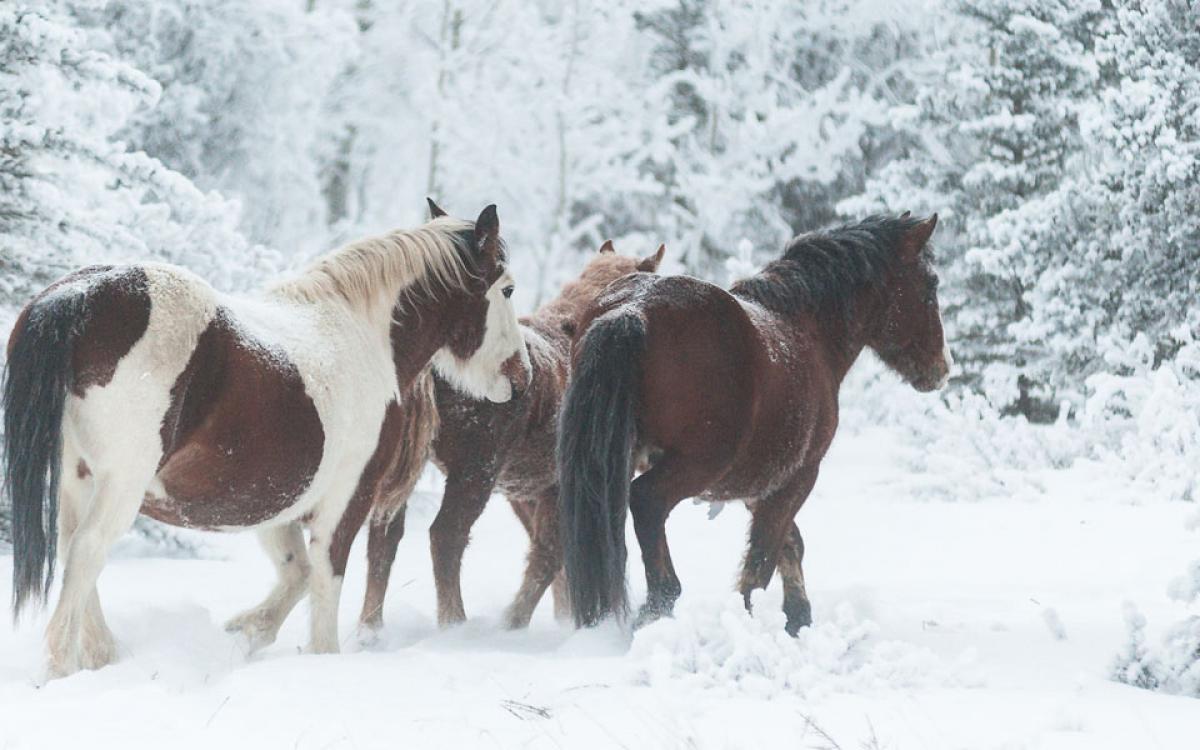Driving along a stretch of Yukon highway, you may catch a glimpse of a band of horses running free across the plains. Look closely enough and you might even see one get hit with a paintball.
For animal control officers, that’s just one tool—along with bear bangers and sirens—to deal with repeat offenders who will not stay off the road between Whitehorse and Haines Junction.
Officials estimate there are fewer than 100 horses that roam the Alaska Highway. Sporadic efforts have been made over the years to corral them—in 2010, 11 horses were rounded up and offered up for auction or adoption. “In the past, there has been really almost no interest on the part of Yukoners to purchase any of these feral horses,” says Mary VanderKop, Yukon’s chief veterinary officer. “It’s not quite as extreme as making a pet out of a wolf. But when they have been on their own for multiple generations, the babies are born in the wild, they’ve never been handled or touched, and they’ve never been confined, it’s quite stressful for an animal.”
No one knows for sure how many horses there are, or where they came from exactly. It’s only been in the last two summers that VanderKop’s department has made an effort to photograph and track the horses to find out more. It’s not that officials didn’t want to know about the horses. It’s just that they’re technically not considered wildlife. “They’re not wild horses. They are feral horses. They’re not considered wildlife under any legislation,” says VanderKop.

Some of the horses may have been turned loose to graze and wandered off from ranches in the last decade. (VanderKop knows of horses that went rogue after their owner died, for instance). Still others were born in the wild and can trace their lineage back more than 100 years. These may be the descendants of outfitters’ horses who made breaks for freedom or were released and never rounded up, dating back to the gold rush. At least, that’s VanderKop’s assumption.
But some paleontologists have a different idea. They’re working to find a link between these horses and ancient horses. “Horses lived in North America right up until the end of the Ice Age,” says Grant Zazula, a Yukon paleontologist. “About 12,000 years ago, the last horses [in North America] go extinct but they survived in Asia and Europe. And then eventually the Spanish conquistadors brought the horses back to the Americas 500 years ago.”
Their first study, focused on North America, came out in 2005. Since then, Zazula and his colleagues have expanded their scope across the whole Northern Hemisphere—collecting fossil bone samples from horses in China from the Ice Age, to go along with samples already recovered in Europe and the Middle East. “What we learned is that they are all genetically in the same group. They also fit genetically with equus caballus, the scientific term for domestic horse. The results we’re getting now, and this is all very preliminary, agree with the North American model—that all Ice Age horses in the last, say, 50,000 years can be grouped genetically with equus caballus. There’s no reason to call them any other name.”
The Yukon is a huge part of the study, Zazula says, because it’s a treasure trove of well-kept bones. “We’re full of horses here from the Ice Age, and they’re probably the best preserved because they’re found in permafrost.”
That means the DNA is intact—so much so that in 2013 they were able to extract the full mitochondrial genome from a 700,000-year-old horse.
“And, what group does it fit in? Equus caballus,” Zazula says, triumphantly. “In science we never kind of ‘prove’ anything, but we can put together a Mount Everest-sized pile of data and evidence and eventually somebody has to believe it. That’s what’s being assembled right now.”
Once an animal is domesticated—or even if it’s reintroduced to a place at a later date—it doesn’t mean it’s genetically distinct. Although ancient horses had a huge range of appearance—some were tiny, standing four-feet-tall, others had larger heads and still others had different markings—Zazula says the DNA doesn’t lie. “We want to use the biological definition of a species, so it’s essentially whether two animals can mate and produce a viable offspring. You could have taken a 12,000-year-old horse from the Yukon and put it in a pen with one of those horses on the Alaska Highway that’s running across the road right now, and they will have a viable offspring.”
This research has present-day ramifications. If they can successfully make the link between these horses, then Yukon’s feral bands can go from invasive nuisance to local wildlife, with all the protections that come with that. “It’s not just an ivory tower navel-gazing question because it has implications for how we treat these animals now. The goal of this study is to eventually use these results to influence
policy,” he says.
That policy could see the feral horses roaming around the highway managed with more than bear bangers and paintball guns. They’d get the same treatment as caribou, bears and other recognized wildlife. “So that’s the lesson that we’re learning—that just because something looks a little bit different doesn’t mean it’s a different species.”









